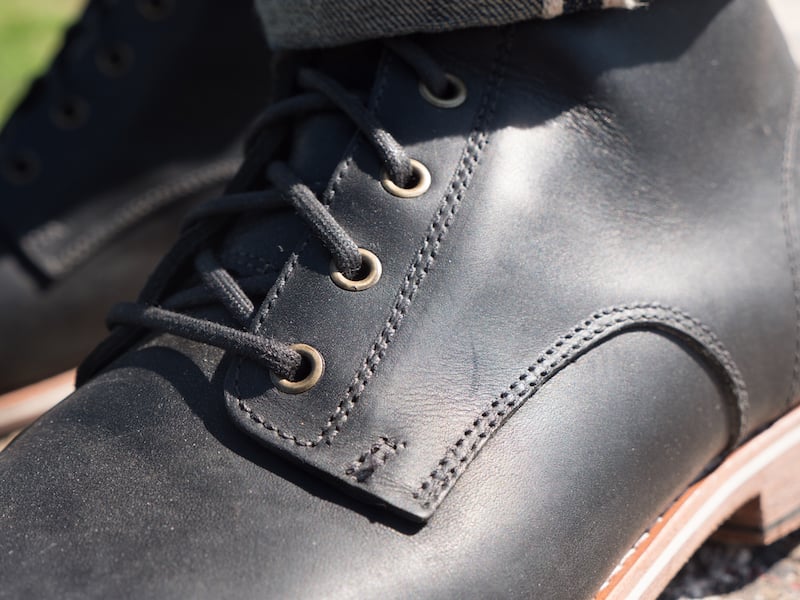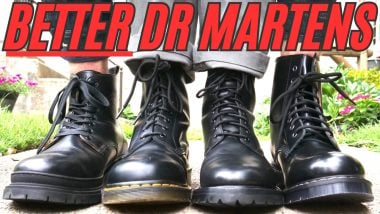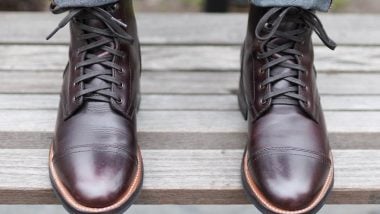Helm Boots Review | Stranger Than You Think
Helm’s a small brand and it’s easy for them to get lost in the shuffle, but there are several elements that make them really stand out in the marketplace.
Maybe some reviewers have called their boots boring, but I’d disagree: between the signature white midsole, unusual combo of work and city boot aesthetics, and the extremely rare Blake rapid construction, I can easily see Helm becoming someone’s favorite brand.
This is an updated look at Helm’s boots. Some four years ago, I (foolishly) produced several full length videos and articles on boots that Helm doesn’t even make anymore, like the Muller cap toe and the Holt Chelsea. I also reviewed the Zind, which ultimately became the brand’s bestseller.
But that review is four years old so in this review, I’m taking a look at their equally popular Hollis boot alongside the Zind to make something of an overview of Helm’s bestselling boots.
The long and short of it is that Helm sells resoleable boots with a combination of light weight, durability, and water resistance that most guys probably didn’t think was possible.
Helm’s Hollis Boots Pros and Cons
In a rush? Here’s a quick breakdown of what I learned in my month of wearing them.
Pros
- Distinct mixture of work and city boot
- Extra lightweight for a boot that’s…
- Resoleable
- Water resistant
- Great shock absorption
- Good value
Lighter than most resoleable boots but still very water resistant, Helm's unusual construction and funky white midsole are stand out in the marketplace.
Cons
- No cork filling in construction, which some guys might miss
- Rare construction is slightly harder to get resoled than Goodyear welted boots
- No speed hooks
- Thin rubber top lift means heel might need frequent repairs
- Design is hard to dress up, try Helm’s Zind if you want more versatility

Helm Boots Aesthetic
Based in Austin and mostly made in Brazil, at the time of writing Helm has a half dozen kinds of boots. Since we’ve been covering the brand (2017) they’ve also put out loafers, derbies sneakers, and sneaker-boots.
There are two things that all their footwear shares: Blake rapid construction (more on that later), and, more conspicuously, a white rubber midsole streaking around every model. One of those two elements would be enough to define a brand on its own, but Helm went in both directions.

Since we’re just talking about aesthetics in this section, I’ll emphasize the boots are plainly for casual wear: not trying to double as work boots, but not overly fashion forward either.
They’re relatively slim and streamlined without leaning into skinny-jeans-only territory. Ultimately, they make longlasting leather footwear for guys who want urban boots that manage to be both simple and memorable.

The bestselling Zind is a straightforward, low profile, plain toe, mid-budget boot that’s ideal for guys who want something plain, casual, and unobtrusive. (White midsole notwithstanding. You might want to imagine the words “white midsole notwithstanding” coming after every statement in this review.)
The Hollis, meanwhile, is an inventive mixture of work boot and dress boot. (Or casual boot and fashion boot, or country boot and city boot, etc.) The goal of combining the work and dress boot is a project many brands have been built on, most notably Thursday Boot Company. (See also Parkhurst, Portland Leather, Red Wing’s ill-fated Williston line, etc.)
So the Hollis is like stripped back, slimmed down work boot: nickel eyelets and a toecap make it reminiscent of Red Wing’s seminal heritage work boot, the Iron Ranger. It also has a luggy-but-not-too-luggy outsole that further adds to the dressed down feel. And yet the boot is much shorter, slimmer, and more streamlined than a work boot, and the construction is more lightweight and flexible.
The “dress boot/work boot hybrid” field is more crowded than ever, but the Hollis is a surprisingly unique entry.

Helm’s Leather Quality
- Hot stuffed leather from Brazil’s Krumenauer tannery
- 2mm thick
- Oily with subtle shine
The tannery is a total no-name brand, the German-sounding Brazilian tannery Krumenauer. But it’s a perfectly nice leather that, at two millimeters, is a good thickness for a longlasting casual boot. It’s pliable, with the shine of a leather stuffed with oils and waxes to boost weather resistance
(I know black leather is a bit boring to look at, but both the Hollis and the Zind come in three or four other colors, some from the Domnican Republic’s B Leather Company.)
Note that since we were introduced to Helm, the leather sourcing has changed a lot: we started out with American-made boots with leather uppers from Chicago’s Horween Leather Company and now it’s Brazilian boots with Brazilian leather.
To be very clear, the cost went south as the country of provenance did, and we feel Helm’s boots are pretty reasonably priced if you get a discount code. (STRIDEWISE at checkout, yo.)

Helm Boots’ Unusual Construction
- Blake Rapid construction
- Lighter than a Goodyear welt
- More water resistant than Blake stitch
- Blake Rapid has no cork filling, which some traditionalist guys miss
- Thick, shock absorbant foam footbed helps make up for it
Besides the white midsole the most unusual thing about Helm’s boots is they are made with Blake Rapid construction.
A quick primer for those new to the high quality footwear game: the most popular way to make a respectable resoleable boot is the Goodyear welt. This is where the upper and midsole are attached to a welt, a strip of material (usually leather) running around the boot’s perimeter. Because the upper and midsole are stitched to a welt instead of each other, it’s much easier to resole them. Plus, this kind of construction is very water resistant and hardwearing.
The Goodyear welt (common on work boots) is usually contrasted with the Blake stitch (common on dress shoes and loafers). Blake stitches are lighter and more flexible and slightly cheaper to make, but less tough and less water resistant. (That doesn’t mean it’s worse — when are you submerging loafers?)
[Further reading: Goodyear welt vs Blake Rapid, what’s best for you?]

The Pros of Blake Rapid Construction?
Blake rapid is the halfway point between the two. The midsole is stitched inside with a Blake stitch method and then the midsole is stitched to the outsole. This makes a boot that’s more water resistant than a Blake stitch but lighter than a Goodyear welt. Or to put it in a way that’s a little more clicky:
This makes a boot that’s more water resistant than a dress shoe but lighter than a work boot
Indeed, I have stood in puddles in Helm boots and my socks have stayed dry; they are surprisingly water resistant.

Weight wise, one of these boots weighs 780 grams. Thursday’s Captain boot (known as very lightweight for a Goodyear welt) is 810 grams, Red Wing’s Iron Ranger is almost 900 grams, and my Nicks boots are about 1,200 grams.

The Cons of Blake Rapid Construction?
What’s the catch, why aren’t all boots just Blake Rapid? Well, they won’t handle quite as much kicking and abuse as a sturdy Goodyear welted boot.
Like their Blake stitched brethren, it’s a little harder to find a cobbler who can resole Blake rapid construction. It can certainly be done, just call around so you don’t turn up with a boot they can’t resole; worst case you’ll need to mail them to a cobbler interstate.
It’s also missing the cork filling that’s sandwiched in the cavity under the insole of a Goodyear welted boot. Boot guys have close relationships with that cork: it helps regulate moisture and temperature, offers limited (old fashioned) shock absorption, and above all it conforms to the shape of your foot with the leather insole, contributing to what feels like a custom fit over time.
That quasi-custom boot feeling is the endgame for many boot fans, it’s why many decide that high end boots are worth it, and Helm doesn’t have it.

The No Cork Compromise
Instead, they put a thick layer of cushy foam on the leather insole. It feels different, less sturdy than an old fashioned welted boot but many guys will find it enjoyable. It absorbs shock super well and feels more like a sneaker than most boots, even other foam insole brands like Thursday.
That foam, combined with the light weight, make Helm a pretty good option for guys who prefer the feeling of sneakers or who aren’t that into heavy, stompy, hard underfoot, Goodyear welted boots.
A small bonus: Helm puts little quotes on the footbed of all their boots, which change seasonally. My Zind boots said, “The goal in life is to discover that you’ve always been where you were supposed to be.” My Hollis have Ralph Waldo Emerson:
Do not go where the path may lead, go instead where there is no path and leave a trail.

Helm’s Outsole
- The Zind and the Hollis have leather outsoles with rubber attached to the heel and forefoot
- The Hollis has really thin rubber on the heel that might need replacing in a year of wear
As far as the outsole goes, you get a leather outsole with lugs attached. The Zind’s is much flatter and doesn’t look “luggy” and super casual like the Hollis.
Folks like leather soles because they breathe well and and are pretty stable (among other reasons) and these benefits are nullified by sticking rubber over it. But you still get some soles that are a little more flexible than 100% rubber.
There’s a nice stacked leather heel made of four layers of vegetable tanned leather that makes the heel easy to repair if you need to — and frankly, you’ll need to. The rubber on the heel (known as the top lift) is very thin and you’ll probably need to replace it after a year or two of wear, especially if you drag your feet. That’s a simple and cheap operation (under $20), but I’d have preferred one less layer of leather and a thicker top lift.

Helm Boots Sizing and Fit
- Order your true size, not your usual boot size
- If in doubt, get measured on a Brannock device
- Wide widths available
- No half sizes after 11.5
Order your true size, do not order your usual boot size.
My sneaker size is 11.5 (sometimes 12) and my boot size is almost always 11, be it in Red Wing, Thursday, Wolverine or almost anyone. But I’m 11.5 in Helm, so your sneaker size is probably your correct size here.
Sizes run 6 to 16, no half sizes after 11.5 (lucky me), and a wide version is available too, which is a nice touch.
As far as comfort goes, the leather took a week or so to soften up but the break in wasn’t too bad, and it was definitely helped by the softer footbed. (Both uppers and insoles contribute to a tough break in.)
The shock absorption is great but, as should be expected, the foamy footbed meant the arch support wasn’t as nice as boots made with more sturdy materials.

Helm Boots Price
- $250 with the code STRIDEWISE
- Full price is a tad high, the discounted price is solid
Helm’s pricing has changed dramatically over the years. They used to have quite a few boots made in America with American leather and they cost close to $400, which wasn’t outlandish for USA boots. Later, they were selling boots made in Brazil with Dominican leather for the same price. That was outlandish.
Now they’re selling Brazilian made boots for under $300, which is actually pretty fair for the quality and construction.
Lighter than most resoleable boots but still very water resistant, Helm's unusual construction and funky white midsole are stand out in the marketplace.
I would give the price a big thumbs up if it were $250, for $295 it’s okay — really, it’s fine. If it were over $300 I’d be like, ‘come on, you’re not made in America.’ The current price is fine and I’m on board with it.
Meanwhile if my discount code STRIDEWISE still works, it drops to $250, which is a really good price for what you’re getting.

Wrapping Up: Are Helm Boots Worth It?
I think Helm boots are a good buy. They’re priced fairly — extremely well if my discount code works — and they’re unlike any other brand I’ve tried in the very crowded world of
Some guys will love the way they’re softer underfoot than traditional boots, some guys will hate it. Some guys love the white midsole, some hate it. I’m just glad someone is trying something different, and I think Helm offers a lot that you won’t find elsewhere.
No boot is without its cons, but I’m happy Helm exists and for a casual urban boot, they’re much more daring than you might have thought.











Join the Discussion